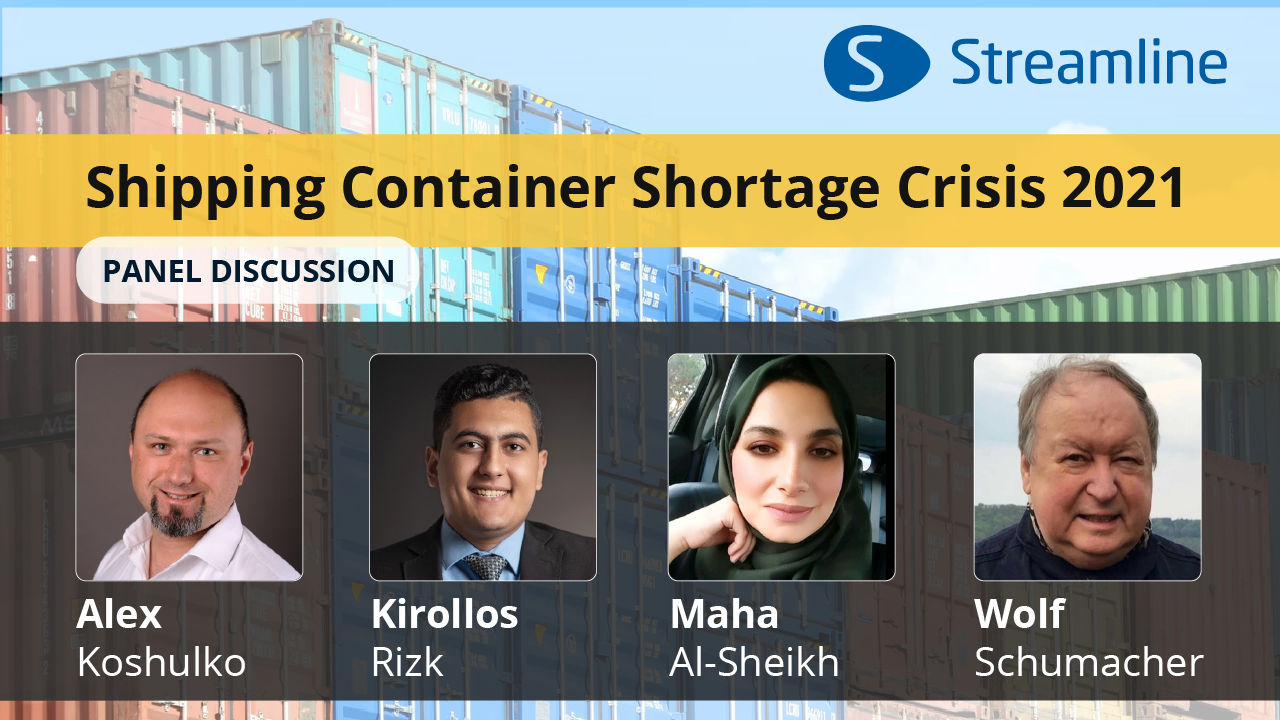Summary of the panel discussion: Shipping Container Shortage Crisis 2021


This panel discussion was organized by GMDH Streamline, a company that develops digital solutions in the supply chain planning industry. The main goal of the round-table meeting was to identify the challenges and opportunities of the current situation with the shipping container shortage crisis, engage in dialogue with supply chain experts around the globe, and find the cooperation potential among supply chain parties for better results in the future.
The participating panelists were:
Alex Koshulko Ph.D., Co-founder of GMDH Streamline, leading supply chain planning expert with more than ten years of experience in demand forecasting, inventory planning, and optimization.
Kirollos Rizk, Lean Manufacturing Section Head, International Supply Chain Consultant & Lecturer of 10,000 students from 130 countries.
Maha Al-Sheikh Ph.D., Assistant Professor of Logistics Operations & Supply chain Risk Management, SCRM Consultant, logistics TOT, CSCP, Commissioner in Jordan Customs & Investment Commission.
Wolf-Dieter Schumacher, Dipl. Volkswirt (MEcon), Owner and CEO of Productive Vision UG & Co KG Bretzfeld Germany. Senior OD and Cloud ERP/SC Consultant to SMEs in the DACH region.
The panel discussion was moderated by Natalie Lopadchak-Eksi, VP of Partnerships at GMDH Streamline, business development & communication expert.
Background
The COVID 19 outbreak sent shock waves to the worldwide economy, and we’re now starting to embrace the full scale of implications, one of which is the supply chain’s disruption in 2021. According to McKinsey, nearly 75% of supply chain companies experienced supply base, production, and distribution hardships due to the pandemic. The shipping industry was among the biggest hit, resulting in transportation ambiguities, shipment delays, and other logistical nightmares.
Main points made during the panel discussion
Reasons behind the container shortage crisis and the current situation
“The supply chain 2021 is generally faced with an unexpected event that causes delays in the world”, said Maha Al-Sheikh Ph.D., “Due to global and regional trade growth, we experience increased demand for containers which is an irregular demand point. Lockdown due to COVID-19 affected the agricultural sector and freight shipping, leading to the lack of containers and effect down into the supply chain and disrupting trade on a global scale. From my academic perspective, container transportation has undertaken most of the transportation tasks with the advantage of the large volume unlock cost, so when we use the container to low production cost between the countries trading. And the container shortage crisis led to transportation costs increasing. Unlimited equipment resources meet the container train terminals and can meet the increasing demand or the volume of the containers. That is the idea of the container shortage.”
“Germany has a strong manufacturing industry, and most sources the parts from China. So, these parts are coming too late or not coming at all”, said Wolf-Dieter Schumacher, “on the other hand, the containers get lost somewhere in America mostly, so the companies in Germany miss out on the containers. On the other hand, we don’t deliver enough stuff out of Germany to other countries because of the pandemic. That is a huge problem.”
“In Egypt, we have a real masterpiece of academic strategies on how to overcome the crisis. Both old-school and modern strategies are fascinating, to be honest. In Egypt, the strongest supply chain was not the supply chain that had lower cost but could refill products in stock and satisfy customer demand. Due to the lack of product availability, the market share in Egypt has changed dramatically. I agree with Alex. I think we aren’t going back to normal. I believe we are creating a new normal right now”, said Kirollos Rizk.
What could be the following consequences and what outcomes we should expect in the future
“Based on my experience and what I’m seeing, transportation costs are not going to return to their initial levels. Due to unsatisfied demand on the one hand and the latest dollar injection, on the other hand, I believe we should expect inflation. We all heard about the bullwhip effect in supply chains, and we always considered it could happen to a single company, but currently, we could see this in the global supply chains. That leads to unnecessary carrying costs, and most probably, we will have this issue in 2022. So, that’s what continues to happen. I think this is an opportunity for domestic suppliers. I predict that everything will get back to a new normal, so let’s adapt,” said Alex Koshulko.
“One of the solutions we must use to overcome all these challenges is supply chain and logistic digitalization and using e-commerce especially. Also, we should see this situation from a different perspective which is increasing space. The other idea is that when we share the strategy to plan the shortage and the surface of two yards, we want to talk about how to increase the high-quality plans, achieve cost savings, create the solution for all the ports, and solve inefficiency in general. I believe the automated freight management system will be a great solution to help with handling all types of goods,” added Maha Al-Sheikh.
When will the supply chain crisis peak
“I think no one knows, but there are good reasons to suspect that the peak will be in 2022,” commented Maha Al-Sheikh.
“For carriers, it is much more profitable to deliver full containers, so nothing happens until they get paid for bringing back empty containers. At the moment, this extreme mismatch, I believe. The peak will be when there’s equilibrium there somehow”, added Wolf-Dieter Schumacher.
“From my perspective, I don’t believe that the peak is going to come soon. We haven’t moved to the drivers of the problem. That is an economic problem, so either we should decrease demand by reevaluating our buying behavior or strengthen the port’s supply power by increasing the number of employees”, added Kirollos Rizk.
The solutions that could help to overcome the container shortage crisis 2021
Nowadays, global business landscape market conditions are changing with the speed of light, and it becomes more and more challenging to make the right managing decisions. But at the same time, we, as humanity, are trying to extend the limits of our knowledge and vision by deploying digital solutions. How effective can it be?
“Supply chain planning software helps to reduce the impact of container shortage. Consider at least economic order quantity and how it changes after transportation costs rise x times. From what I’ve seen in many companies, EOQ is calculated once a year, but now you need to calculate it more often, and you would need some digital solution to take care of that. We are talking about the minimum purchasing quantities that we need to wait for while the shortages with containers and transportation costs go down. We would need to calculate, for instance, an equal number of weeks of supply for all items in a container; then, we can purchase container by container. Again, this is hard to achieve without automation. And of course, we are dealing with unpredictable lead times, delivery dates, and at least we can start reacting fast to any changes when using digital solutions. Acting fast based on available information requires digital solutions”, said Alex Koshulko.
“As I mentioned, we mostly deal with small and medium-sized businesses, and we find there that the systems these companies use are not integrated at all. And as Alex pointed out, quite often the planning is only done at least annually, so they can’t count on the real-time changes which I do believe is very important. Companies need to adapt to customers’ orders, so they need to look at their supply chain in real-time. It would be essential to have integration and real-time tracking, which are highly desirable in this space. As Gartner mentioned in recent research, real-time transport visibility platforms will be a part of the solutions in the future. From my perspective, the companies need more automated processes,” added Wolf-Dieter Schumacher.
“We have a shortage in supply, and we have huge peaks in demand. And the more demand increases, the prices are going to grow accordingly. If we look into this matter from a wider perspective, globalization is always driven by time and cost. Right now, time is not the winning factor, so I guess this will open the door for the local competitors. So, the small and medium-sized companies that are going to rise now need the right tools. That is where the role of planning software comes in. This software is going to help companies calculate market needs accurately”, pointed out Kirollos Rizk.
“One of the solutions is sharing space between the yard operation container terminals and circles. The other solution is using digital supply chain solutions. We must use our capacity in the ports, and we must increase our freight service to return our investments”, summarised Maha Al-Sheikh.
The entire panel discussion is available for watching:
Too much manual work in Excel?
See what Streamline can do for you
- 99+% inventory availability.
- Up to 99% forecast accuracy.
- Up to 98% reduction in stockouts.
- Up to 50% reduction in excess inventory.
- 1-5 percentage points margin improvement.
- Up to 56X ROI in one year. 100% ROI in the first 3 months.
- Up to 90% reduction in time spent on forecasting, planning, and ordering.
